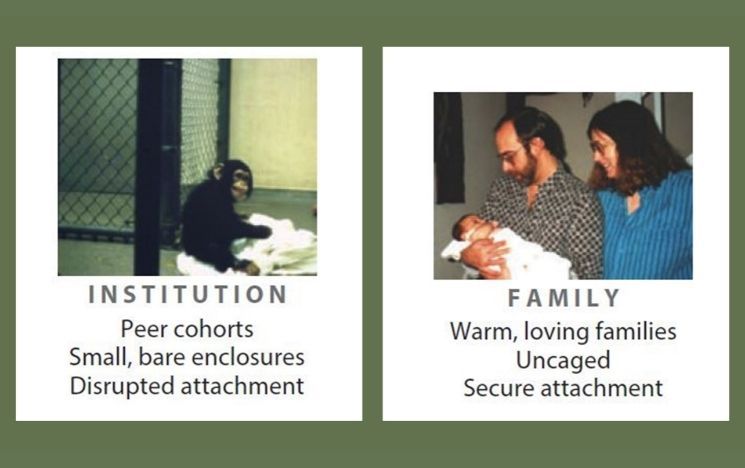Revealing animal strengths
Many researchers, worldwide, are interested in what makes humans psychologically distinct from other animals, but sometimes this work can make animals look like substandard humans. We're interested in fair and balanced research methods that allow animals to showcase their talents. We aim to (1) design research that makes sense to our animal participants, and (2) raise consciousness about the limits of experimental methods, both in theory and practice.

The popular science press is filled with claims of human cognitive exceptionalism. Many of these claims are based on direct comparisons of humans with great apes living in captivity.
Typically, the apes are born and housed in cages, many of them are orphans, almost always the apes are much older than the humans, and often the experimental tasks are not appropriate to older individuals. Almost never is the exact, same task administered in exactly the same way to apes and humans.
Dave Leavens, with his collaborators—including, among others, Kim Bard, Sarah Boysen, Bill Hopkins, Tim Racine, Heidi Lyn, Mark Krause and our own Hannah Clark—is concerned about how incommensurate experimental methods bias results against great apes, artificially depressing their performances in widely used protocols.
Bad practice 1: comparing institutionalised apes with non-institutionalised humans
There are many published claims of human superiority in social cognition, based on comparisons of great apes living in institutions with human children who have been raised in intact family units, typically in the West.
When tested on their understanding of conventional European non-verbal cues, human children often out-perform the apes, but this is not a legitimate research design, because the institutionalised apes have been obviously disadvantaged by their austere early rearing experiences.
Solution 1: compare like with like
One solution to this systemic problem is to look at the performances of apes that have been raised in human family-like environments (‘cross-fostered’ or ‘enculturated’ apes).
While the balance of opinion, today, is that it is unethical to raise apes in this way, there are still a number of animals who have been raised in environments rich with interactions with people, such as the language-trained apes. Such enculturated apes have no difficulty understanding simple nonverbal cues, and they perform comparably to human children in experimental studies of their understanding of human nonverbal communication.
Bad practice 2: comparing young humans with older apes
Many claims of human superiority in social cognition are based on studies comparing very young children with much older great apes.
The problem is that older individuals may not respond to experimental task demands in the same way as young children, not because—in this case—they are members of different species, but because older individuals are not as interested in the task as younger individuals.
Solution: the Horowitz Validation Protocol
A simple solution to the problem of an experimental task that is not validated for use with adults is to simply apply the procedure to university undergraduates.
Alexandra Horowitz was the first to apply this validation procedure in a study of imitation, and she found that human adults and pre-adolescent chimpanzees performed similarly—both groups differed from younger children in this imitation task.
We applied the Horowitz Validation Protocol to university students in a test of the ability to follow human gaze cues to the location of hidden treats.
In an original study by Daniel Povinelli and his colleagues, they reported that three-year-old human children failed to use an experimenter’s gaze direction to find rewards hidden in one of two containers, but six-year-old chimpanzees succeeded in this task.
In this condition, the experimenter looked not at the baited container but stared at a point above the baited container. Povinelli and his colleagues argued that this is because the children had advanced socio-cognitive capacities for understanding gaze as a kind of laser beam, and could not, therefore, link the gaze direction with the location of the reward. In contrast, they argued, the chimpanzees simply used the fact that the experimenter’s head was oriented to one side or the other and used this cue to find the food.
Dave Leavens and his students were sceptical of this interpretation—in which superior performance by apes was interpreted as evidence of inferior cognitive capacities - and we applied this task to university students, finding that these human adults, like the six-year-old chimpanzees in the original study by Povinelli and his colleagues, had no difficulty using these ‘above-target’ cues to find the hidden rewards.
In ongoing work, Dave and his students are consistently finding that when we test various experimental protocols on young adult university students, they respond very much like adolescent and young adult great apes. These findings suggest that what were previously interpreted as ape-human species differences are actually experimental artefacts attributable to previous failures to match apes and humans on life-history stage.